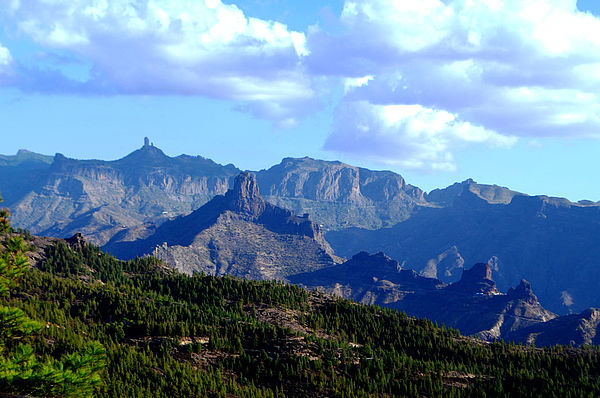Guía, Fontanales, Artenara and at last, at the end of our walk, we come to Pico de La Bandera. But let us give you our recommendation from the start of the walk. Let’s go back.
A walk around the northern region of Gran Canaria enables us to reach the Tamadaba Natural Park, one of the island’s territories that has escaped human alterations the most. Once we are in the Park, starting at Artenara, we walk seven kilometres towards Tamadaba.
Along the way we can go off the path to see several viewpoints, and after the seven kilometre stretch, to our right, we can see the start of the walk to Pico de La Bandera.
Look out for a sign for footpaths on the edge of the road, and on the opposite side, some stone steps. This signals the start of the path we should follow.
The route kicks off with a gentle rise, which takes us through some typical local flora for around forty minutes, including pine trees that have adopted some curious shapes as they struggle to fit into their surroundings, with refreshing aromas and the natural beauty the island offers as we make our way into its interior.
Although as its name suggests, Canary Pine predominates in this region, it is accompanied by a whole range of other undergrowth comprising heather, small, wild olive trees and a multitude of ferns. As for wildlife, highlights would be the woodpecker and the blue chaffinch, while other birds easily spotted include hawks, kestrels and to a lesser extent, crows.
Following our stroll through ferns and pines, hearing nothing more than the whistling of the breeze on the leaves of trees, or the odd creature such as a cricket chirping away from about six o’clock in the evening, we can make out the stunning landscape that opens up before us under the blue skies. This is a strategic point at over four hundred metres altitude, a place to take in the sheer majesty of our great little territory.

Indeed, there are rewards to be had on this pleasant and comforting ramble. We need only look out over the hillsides to be greeted by gorgeous natural monuments such as the Bentayga rock and the Roque Nublo, that stand in slim, silent majesty over all those who come to marvel at them, or just get carried away by the steep, plunging ravines.
There are no city sounds around here. The natural environment is enveloped in silence, enabling us to enjoy nature in all its simplicity. Come along to this spot, and lose yourself as you see the island from a whole new perspective.
You may suddenly be startled by a piercing ferry horn. This sound filters up from the dock in Agaete down below, and it is able to skip over the thick and lush hills and reach our ears, ears that I bet my life are fighting tooth and nail with our eyes as to which of the senses is getting most enjoyment out of it all.
Aside from such debates, we come to the end of our walk today at Pico de La Bandera. It is a place where all of nature’s power can be seen to fuse together into one common beauty, which is what we have come for at the end of the day. No matter which sense we use the most, we simply understand that the most important thing is to feel, live and enjoy. As we arrive at this spot, we realise we are on the right track.
Take the North Motorway, the GC 2, to Agaete. At the roundabout follow the GC-172 as far as the crossroads where we take the CG-200 towards Artenara. Once there we should ask or follow on towards Tamadaba, for another seven kilometres, until we reach the indications mentioned in the text, a vertical sign with several different routes on the right of the road and the stone steps to our left.
- La Cuevita Sanctuary: located in Artenara, this sanctuary is home for a wooden carving of the Virgin Mary 80 measuring centimetres high. The building was carved out of rock over the final third of the 19th century, where the altar, chorus area, pulpit and confessionary were also erected.
- Casas Cuevas Museum: this museum is also in Artenara, and occupies a former house cave with seven rooms. Here we can observe the site where the local pre-Hispanic population lived. With typical furnishings from the period, including the most common trade tools, visitors can see the means and customs that provide a great insight into our history, all in a pleasant, quiet setting, with the twittering of birds in the background.
- La Rama Museum: this museum is located in another of the towns comprising our itinerary, Agaete. It is solely dedicated to a single traditional Fiesta, called La Rama, which is of enormous importance to Gran Canarians. The museum is situated along Calle Párroco Alonso Luján number 5, in the village of Agaete.